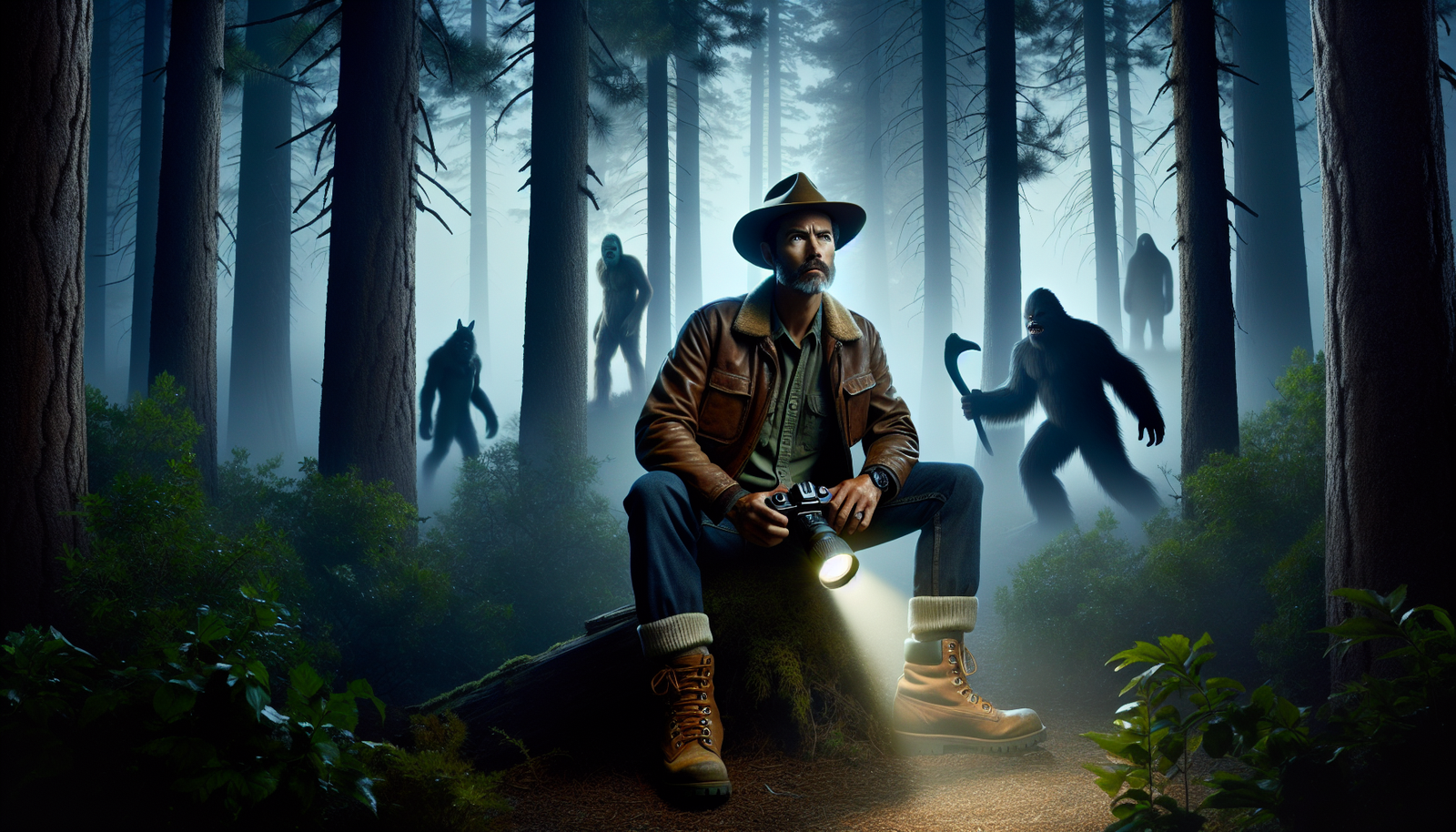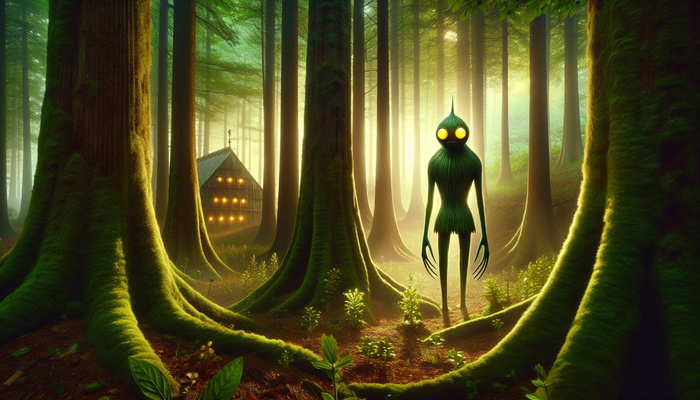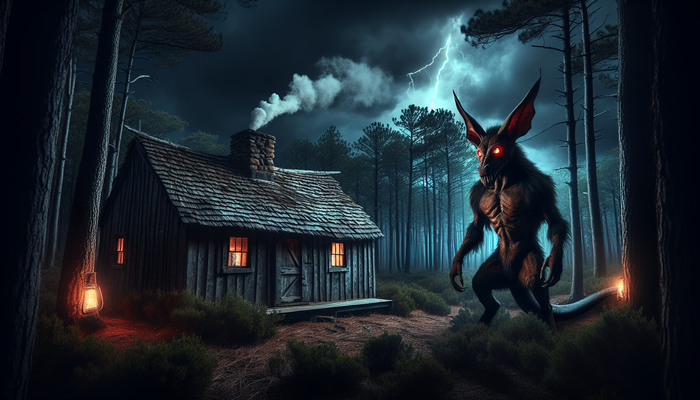Montana's Mysterious Cryptids

By Oliver Bennett, Bigfoot Researcher and Teacher
In the heart of the American West lies Montana, a land of breathtaking beauty and untamed wilderness. Amidst its towering peaks, vast forests, and pristine lakes, whispers of mysterious creatures echo through the ages. These enigmatic beings, known as cryptids, have captured the imagination of locals and visitors alike, weaving themselves into the rich tapestry of Montana's folklore. As a researcher and writer, I, Oliver Bennett, have long been fascinated by the tales of these elusive creatures. Join me on a journey as we delve into the shadows and attempt to unmask the truth behind Montana's most intriguing cryptids.
The Shunka Warak'in: Montana's Enigmatic Wolf-Hyena
Our first stop takes us into the realm of the Shunka Warak'in, a creature deeply rooted in Native American folklore, particularly among the Ioway people. The name "Shunka Warak'in" translates to "carries off dogs," alluding to the creature's alleged habit of sneaking into camps and snatching canines in the night. Descriptions of this enigmatic beast paint a picture of a wolf-like creature with the sloping back and hyena-like features, covered in dark fur and emitting haunting, human-like cries.
The legend of the Shunka Warak'in took a fascinating turn in 1886 when a rancher named Israel Ammon Hutchins encountered a strange creature on his property. Hutchins shot and killed the beast, and its carcass was later transformed into a taxidermy mount that became known as the "Ringdocus." This peculiar specimen, with its wolf-like appearance and unusual proportions, has been a subject of intense debate among cryptozoologists and skeptics alike.
In 2007, the Ringdocus resurfaced after decades of obscurity, reigniting interest in the Shunka Warak'in legend. The mount, now housed in a Montana museum, has undergone scrutiny from various experts, each attempting to unravel the mystery of its true identity. Some dismiss it as a misidentified wolf, a dog, or even a clever hoax, while others speculate that it could be evidence of a prehistoric survivor, such as the Borophaginae or the American hyena.
Despite the ongoing debates, one thing remains clear: the Ringdocus and the legend of the Shunka Warak'in continue to captivate those who seek to unravel the mysteries of Montana's wilderness. As a researcher, I can't help but wonder if DNA testing of the Ringdocus might provide some much-needed answers, but for now, the enigma of this wolf-hyena hybrid remains unsolved.
Flessie: The Flathead Lake Monster
From the dense forests, we turn our attention to the sparkling waters of Flathead Lake, the largest freshwater lake west of the Mississippi. Here, another cryptid has been making waves for over a century: Flessie, the Flathead Lake Monster. The first recorded sighting of this elusive creature dates back to 1889 when Captain James C. Kerr and his crew aboard the steamboat U.S. Grant claimed to have seen a massive, serpentine creature swimming in the lake.
Over the years, numerous eyewitness accounts have surfaced, each describing Flessie as a long, eel-shaped entity with dark skin and piercing, steel-black eyes. The year 1993 marked a particularly active period for Flessie sightings, with an astonishing 13 reports filed by locals and visitors alike. These accounts paint a picture of a creature that is as mysterious as it is captivating.
One of the most intriguing aspects of the Flessie legend is the notion that this creature might possess a benevolent nature. A story that has captured the hearts of many involves a young boy who claims to have been saved from drowning by a mysterious "monster" in the lake. Could this be evidence of Flessie's gentle side, or merely a child's imaginative interpretation of a near-death experience?
Skeptics, of course, offer alternative explanations for Flessie sightings, ranging from misidentifications of large fish like sturgeon to optical illusions caused by the interplay of light, water, and the human mind. However, the impact of this cryptid on local culture and tourism is undeniable. Flessie has become a beloved figure in Montana folklore, inspiring artwork, festivals, and even a line of gourmet sodas.
As a researcher, I find myself drawn to the mystery of Flessie and the enduring allure of lake monsters worldwide. While concrete evidence may be elusive, the stories and legends surrounding these creatures serve as a testament to the human fascination with the unknown and our deep-seated desire to believe in something extraordinary lurking beneath the surface.
Bigfoot: The Elusive Ape-Man of the Montana Forests
No exploration of Montana's cryptids would be complete without delving into the legend of Bigfoot, the elusive ape-man said to roam the state's vast wilderness. Montana consistently ranks among the top states for Bigfoot sightings, with reports emanating from remote areas and national forests throughout the region.
One of the most notable Bigfoot encounters in Montana occurred in 1993 when three backpackers in the Gallatin National Forest reported seeing a large, dark figure moving swiftly through the dense underbrush. The witnesses described the creature as having a human-like form but with an ape-like gait, disappearing into the forest as quickly as it had appeared. Similar reports have emerged from the Bitterroot Mountains, the Bob Marshall Wilderness, and the Lolo National Forest, each adding to the growing body of evidence surrounding Bigfoot's presence in Montana.
While physical evidence of Bigfoot remains elusive, researchers and enthusiasts continue to investigate the phenomenon, collecting and analyzing eyewitness accounts, strange vocalizations, and large, humanoid footprints found in remote areas. The search for conclusive proof of Bigfoot's existence has become a passionate pursuit for many, driven by the tantalizing possibility that an undiscovered species of primate may be lurking in the shadows of Montana's forests.
As a researcher, I approach the Bigfoot phenomenon with a mix of open-mindedness and healthy skepticism. While the sheer volume of sightings and anecdotal evidence is compelling, the lack of definitive physical proof leaves room for doubt. However, the enduring fascination with Bigfoot and the ongoing efforts to unravel this mystery serve as a testament to the power of legend and the human desire to explore the unknown.
The Wendigo: A Terrifying Legend from Native American Lore
Delving deeper into the realm of Montana's cryptids, we encounter the Wendigo, a terrifying creature born from the folklore of various Native American tribes, including those of the Plains and Great Lakes regions. The Wendigo is often described as a tall, gaunt, humanoid being with a deer skull for a head and an insatiable hunger for human flesh.
According to legend, humans who resort to cannibalism in times of desperation or greed are at risk of becoming Wendigos themselves. This transformation is said to be both physical and spiritual, with the afflicted individual taking on the grotesque appearance and unrelenting hunger of the Wendigo. The legend serves as a powerful cautionary tale, warning against the dangers of consuming human flesh and the corrupting influence of greed.
While the Wendigo is more commonly associated with the forests of Minnesota and Canada, there have been alleged sightings and encounters in the remote wilderness areas of Montana. Some stories even suggest that the Wendigo's presence can be felt as an unsettling, malevolent force in the woods, making those who venture too deep into the forest feel watched and uneasy.
As a researcher, I find the Wendigo legend to be a fascinating example of how folklore can serve as a moral compass, guiding human behavior and reinforcing cultural taboos. The story of the Wendigo, with its themes of cannibalism, greed, and transformation, speaks to the darker aspects of human nature and the consequences of straying from the path of righteousness.
Lesser-Known Montana Cryptids
While the Shunka Warak'in, Flessie, Bigfoot, and the Wendigo may be the most well-known cryptids associated with Montana, the state's vast wilderness is home to a host of other mysterious creatures that have captured the imagination of locals and researchers alike.
One such entity is the Pukwudgie, a small, mischievous humanoid creature that originates from the folklore of the Wampanoag people. Standing between two and three feet tall, Pukwudgies are said to possess large ears, fingers, and noses, and are known for their ability to appear and disappear at will. While these trickster entities are more commonly associated with the forests of Massachusetts and Delaware, there have been sporadic reports of similar creatures lurking in the woods of Montana.
Another cryptid that has been reported in Montana is the Thunderbird, a giant avian creature often described as having a wingspan that can block out the sun. Thunderbird legends are prevalent among various Native American tribes, and sightings of these enormous birds have been reported throughout the state. Some researchers speculate that these sightings could be attributed to large, migratory birds like condors or eagles, while others believe that the Thunderbird may be a yet-undiscovered species of giant avian.
Montana's numerous lakes and rivers have also given rise to tales of aquatic monsters, with sightings of strange, serpentine creatures reported in bodies of water across the state. These accounts often describe creatures that resemble giant snakes or eels, with some witnesses even claiming to have seen them basking on the shoreline or swimming alongside boats.
Werewolf-like creatures have also found their way into Montana's cryptid lore, with reports of bipedal, wolf-like entities stalking the forests and wilderness areas. These sightings often describe creatures that are larger and more muscular than typical wolves, with a decidedly more human-like posture and gait.
As a researcher, I find the lesser-known cryptids of Montana to be just as intriguing as their more famous counterparts. These stories, often passed down through generations or shared among locals, serve as a reminder of the rich folklore and cultural heritage that permeates the state. While some may dismiss these tales as mere superstition or overactive imaginations, they nonetheless contribute to the enduring mystery and allure of Montana's wilderness.
The 2018 Denton Wolf Incident
In 2018, a peculiar incident in Montana made headlines and reignited interest in the state's cryptid lore. Near the town of Denton, a strange, wolf-like creature was shot and killed, its unusual features puzzling wildlife officials and sparking speculation among cryptozoology enthusiasts.
The animal's appearance was unlike that of a typical wolf, with shorter legs, larger ears, and a coat that varied in color from the usual gray or black. The strange proportions and atypical features of the creature led to rampant speculation, with some suggesting that it could be a Shunka Warak'in, a Dogman, or even a surviving dire wolf, a prehistoric species thought to have gone extinct thousands of years ago.
As news of the Denton wolf spread, the creature's carcass was sent for DNA testing to determine its true identity. The results, however, proved to be somewhat anticlimactic: the animal was indeed a gray wolf, albeit one with some unusual physical characteristics. Wildlife officials attributed these differences to potential genetic anomalies or developmental quirks, rather than any supernatural or cryptozoological explanation.
Despite the DNA results, the Denton wolf incident serves as a prime example of how cryptid legends and human fascination with the unknown can be fueled by seemingly inexplicable events. The story of this unusual wolf spread like wildfire, capturing the imagination of people across the country and beyond, and adding yet another chapter to Montana's rich history of cryptid lore.
As a researcher, I find incidents like the Denton wolf to be both fascinating and instructive. They highlight the importance of maintaining a skeptical, evidence-based approach when investigating claims of cryptid sightings or encounters. While it can be tempting to jump to extraordinary conclusions when faced with the unknown, it is crucial to exhaust all logical explanations and rely on scientific evidence before considering more fantastical possibilities.
Investigating Montana's Cryptids: Separating Fact from Fiction
The study of cryptids, known as cryptozoology, is a field that often walks the line between science and speculation. While the allure of discovering a previously unknown species or unraveling a centuries-old mystery is undeniable, it is essential to approach the investigation of Montana's cryptids with a critical eye and a commitment to separating fact from fiction.
One of the most important aspects of cryptozoological research is maintaining a healthy level of skepticism. Many sightings and encounters can be attributed to misidentifications of known animals, optical illusions, or even deliberate hoaxes. For example, a large, dark figure moving through the forest might be mistaken for Bigfoot, when in reality, it could be a bear, a moose, or even a human wearing dark clothing. Similarly, unusual tracks or footprints could be the result of natural geological formations or the work of pranksters seeking to capitalize on local legend.
To effectively investigate Montana's cryptids, researchers must rely on scientific evidence and thorough, unbiased analysis. This involves collecting and examining physical evidence, such as hair samples, footprints, or even alleged DNA evidence, and subjecting these materials to rigorous testing and verification. Eyewitness accounts, while valuable, should be treated with caution and corroborated by additional evidence whenever possible.
Another crucial aspect of cryptid research is respecting the wildlife and environment of the areas being investigated. Montana's wilderness is home to a diverse array of flora and fauna, many of which are protected by law. Researchers must take care not to disturb habitats, harass animals, or engage in any activities that could have a negative impact on the ecosystem. By conducting investigations responsibly and ethically, cryptozoologists can help to preserve the natural beauty and integrity of Montana's wild spaces.
For those interested in learning more about Montana's cryptids and the field of cryptozoology, there are numerous resources available. Books like "Paranormal Montana" by Greg Strandberg offer in-depth explorations of the state's legendary creatures and the broader world of cryptid research. Websites such as the Bigfoot Field Researchers Organization (BFRO) and Cryptozoology News provide databases of sightings, encounters, and ongoing investigations, as well as forums for enthusiasts to share their experiences and theories.
As a researcher, I believe that the investigation of Montana's cryptids represents an exciting and endlessly fascinating field of study. By approaching these legends with a mix of open-mindedness and scientific rigor, we can work to unravel the mysteries that have captivated generations of Montanans and cryptozoology enthusiasts alike. Whether or not we ever find definitive proof of creatures like the Shunka Warak'in, Flessie, or Bigfoot, the search itself is a testament to the enduring power of human curiosity and our deep-seated desire to explore the unknown.
The Enduring Legacy of Montana's Cryptids
Montana's cryptids are more than just stories or legends; they are an integral part of the state's cultural heritage and identity. For generations, these mysterious creatures have captured the imagination of locals and visitors alike, weaving themselves into the fabric of Montana's rich history and folklore.
The tales of the Shunka Warak'in, Flessie, Bigfoot, and other cryptids have been passed down from parent to child, from elder to youth, each retelling adding new layers of intrigue and wonder to the original stories.
From Bigfoot to UFOs: Hangar 1 Publishing Has You Covered!
Explore Untold Stories: Venture into the world of UFOs, cryptids, Bigfoot, and beyond. Every story is a journey into the extraordinary.
Immersive Book Technology: Experience real videos, sights, and sounds within our books. Its not just reading; its an adventure.



























